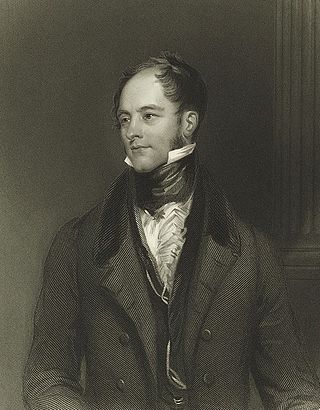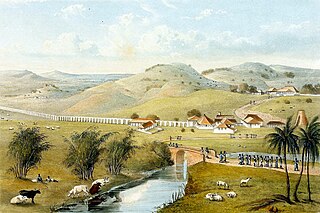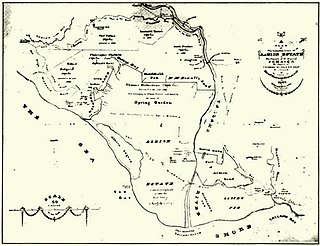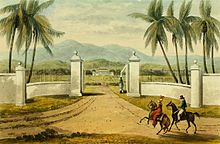
Henry Goulburn PC FRS was a British Conservative statesman and a member of the Peelite faction after 1846.

Hanover is a parish located on the northwestern tip of the island of Jamaica. It is a part of the county of Cornwall, bordered by St. James in the east and Westmoreland in the south. With the exception of Kingston, it is the smallest parish on the island. Hanover is the birth parish of Alexander Bustamante, labour leader, first head of government of Jamaica under universal suffrage, and one of seven Jamaican National Heroes. Its capital is Lucea.

Charles Rose Ellis, 1st Baron Seaford was a British politician, sugar planter, and slave holder.

James Dawkins was a member a British Member of parliament, antiquarian, Jacobite and sugar planter and slave owner in Jamaica.

The Centre for the Study of the Legacies of British Slavery, formerly the Centre for the Study of the Legacies of British Slave-ownership, is a research centre of University College, London (UCL) that focuses on revealing the impact of British slavery and, in particular, the implications of the Slave Compensation Act 1837. The Centre's work is freely available online to the public through the Legacies of British Slavery database.

Henry Dawkins II was a Jamaican plantation and slave owner and Member of the Parliament of Great Britain (MP).
Eleanora Atherton was an English philanthropist best known for her work in Manchester, England. At the time of her death, she was one of the richest British women in the nineteenth century.

Nathaniel Bayly was an English owner of West Indies plantations and a politician who sat in the House of Commons from 1770 to 1779.
Hamilton Brown was a Scots-Irish planter, slave owner, and politician in Saint Ann Parish, Jamaica, which he represented in the House of Assembly of Jamaica for 22 years. Brown founded the settlement of Hamilton Town in Saint Ann Parish, which was named after him.
Peter Robertson was a planter and slave-owner in Jamaica. He owned Dunrobin Plantation, Friendship Valley Pen, Prospect pen, and the Weybridge Estate, and had interests in others. He was elected to the House of Assembly of Jamaica in 1820 for the parish of Saint Thomas-in-the-East.
Samuel Williams Haughton (1738–1793) was the speaker of the House of Assembly of Jamaica from 1778 to 1793.
Zachary Bayly (1721-1769) was a wealthy planter and politician in Jamaica.

Trinity was a plantation in colonial Jamaica, located south of Port Maria, in Saint Mary Parish, one of several plantations owned by Zachary Bayly that formed part of the area known as Bayly's Vale. By the early nineteenth century, over 1,000 people were enslaved there producing mainly sugar and rum for which a mile-long aqueduct was built by Nathaniel Bayly to supply water for the refining process.

Albion was a sugar plantation in Saint David Parish, Jamaica. Created during or before the 18th century, it had at least 451 slaves when slavery was abolished in the British Empire in 1833. By the end of the 19th-century it was the most productive plantation in Jamaica due to the advanced refining technology it used. By the early 20th century, however, its cane sugar could not compete with cheaper European beet sugar, and it produced its last sugar crop in 1928. It subsequently became a banana farm for the United Fruit Company.

Edward McGeachy was the Crown Surveyor for the county of Surrey in Jamaica. He trained Thomas Harrison, the first Government Surveyor of Jamaica. He owned Bull Park plantation and Brighton Pen in Saint David Parish and in 1837 received compensation for the loss of eight slaves following the abolition of slavery in the British Empire in 1833.

The West Indian Incumbered Estates Acts were Acts of the Parliament of the United Kingdom of 1854, 1858, 1862, 1864, 1872, and 1886 that allowed creditors and other interested parties to apply for the sale of estates (plantations) in the British colonies in the West Indies despite legal encumbrances that would normally prevent such a sale. The legislation was modelled on the acts that created the Irish Encumbered Estates' Court after the Great Famine of the 1840s that allowed indebted and moribund estates to be sold.
William Dickinson (1771–1837) was an English politician, in parliament from 1796 to 1831.

Margaret Macpherson Grant was a Scottish heiress and philanthropist. Born in Aberlour parish to a local surgeon, she was educated in Hampshire, and was left an only child when her elder brother died in India in 1852. Two years later, she inherited a large fortune from her uncle, Alexander Grant, an Aberlour-born planter and merchant who had become rich in Jamaica.
William Atherton, was a merchant and wealthy landowner from Lancashire, England, who operated and co-owned sugar plantations in the former Colony of Jamaica. He was a slave owner, as well as an importer of slaves from Africa.
Green Park Estate was one of several sugar plantations owned by William Atherton and his heirs. It was located in Trelawny Parish, south of Falmouth, Jamaica. By the early nineteenth century, at least 533 people were enslaved there producing mainly sugar and rum.






















